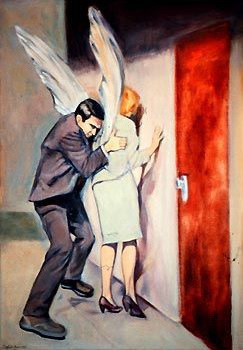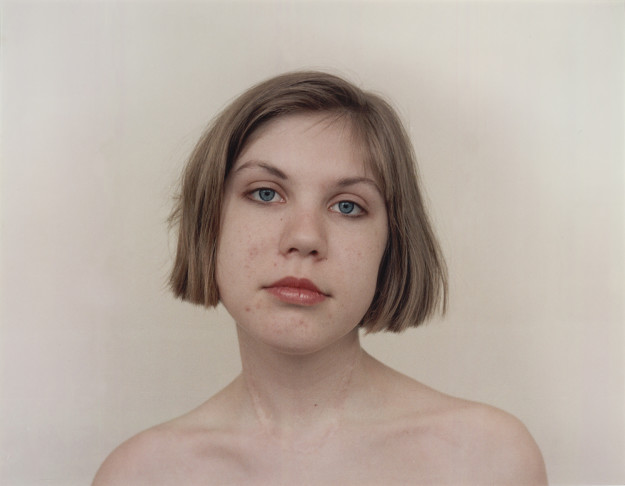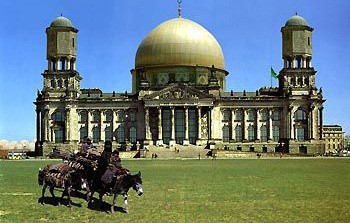
Ágnes Szépfalvi, Angel , 1998 © Ágnes Szépfalvi
After the Wall
Art and culture in post-Communist Europe
16.10 1999 – 16.1 2000
Stockholm
The autumn of 1999 will mark ten years since the demolition of the Berlin Wall. To coincide with this Moderna Museet has over the past two years been planning a research programme entitled After the Wall. This consists of an exhibition, an extensive book/catalogue and a symposium . The purpose of this project is to map contemporary art and manifestations (visual art, photography, video and film) in the post-communist countries to shed light on the present situation in terms of the cultural changes that have taken place.
After the Wall focuses on the period from the mid-1980s to the present which has been marked by many dramatic political and cultural changes in Eastern and Central Europe and the former Soviet Union. Perestroika, the shattering of the “Iron Curtain”, the end of the Cold War, the foundation of new states and their ways towards democracy, the reunification of Germany, ‘ethnic c leansing’ and the Balkan and Chechen Wars have all marked this time within the post-totalitarian landscape. At first tentatively but with increasing intensity new forms of culture have begun to emerge.
This time has also been marked by a systematic restructuring of artistic and cultural life within almost every post-communist country. It has been characterised by the end of “dissidence”, the removal of monopolistic Ministries of Culture, the foundation of new arts centres (including the network of Soros Centres for Contemporary Art) the appearance of new art magazines, private galleries and art fairs, the death of state propaganda and the proliferation of the mass media, the impact of the Internet and the “westernization” of cultural life.
Faced by new freedoms and sharing a hunger for change, many artists became initially preoccupied with the deconstruction of their totalitarian past and its icons. After a time of enthusiasm, chaos and confusion, a new generation of artists has emerged which did not feel responsible for the past and had not been subjected to communist ideology. These greater freedoms have, however, been balanced by a much darker picture: widespread poverty, industrial wastelands, high levels of unemployment, toxic polution, nationalistic racism, homelessness and a cynical attitude towards new values.
After the Wall is concerned primarily but not exclusively with this younger generation of artists. As elsewhere in the world, this generation has shown an impressive energy and independence which has been largely formed by the changed political, cultural and social climate in which they have grown up.
The work in the exhibition reflects the diversity of the actual situation in the twenty two post-communist countries of Europe. Accordingly the project does not seek to draw general conclusions, nor to provide a totalizing view of a ‘phenomenon’, nor to construct new forms of ‘otherness’. In an area which stretches from eastern Germany to the Transcaucasian republics, from the Balkans to the Baltic such an ambition would be foolhardy. The aim of the project, rather, is to create a discourse in images and words which reflects the complexities and variety which may be found within individual artists’ works
About the Exhibition
After the Wall is not an exhibition of political art but one which examines individual artistic attitudes, which may or may not, refer directly to the political and social context in which they were formed. Many of the artists included still live in their native countries, others now work abroad. The exhibition includes painting, sculpture, video, photography, film and installation work made during the last decade as well as a number of specially commissioned projects.
The exhibition consists of four sections
I. SOCIAL SCULPTURE
This includes work which deals critically with issues of social economy, national identity, religion,race, consumerism, poverty, alienation and the impact of the mass media.
II, RE-INVENTING THE PAST
Many artists have had to confront the artistic traditions in which they grew up, both in terms of ideology and nationhood.
III. QUESTIONING SUBJECTIVITY
As in the West, many people have been questioning the nature of artistic subjectivity with private narratives of their own and different forms of self representation.
IV. GENDER SCAPES
Stereotypes of various aspects of femininity and masculinity can refer critically to previous ideologies but new forms of gender representation are developing out of this. A number of artists have also explored the actuality and metaphor of mortality.
Participating artists
AES, Ryssland
Alksnins, Arvids/ Kimelis, Peteris/ Licis, Dzintars/ Ratniks, Martins/ Lettland
Antoshina, Tatyana Ryssland
Beban, Breda/Horvatic, Hrvoje Kroatien
Benczúr, Emese Ungern
Boyadjiev, Luchezar Bulgarien
Bromová,Veronika Tjeckien
Bubelyte, Violeta Litauen
âekiç, Jovan f.d Jugoslavien
âernick, Jifií Tjeckien
âern, David Tjeckien
Csörgö, Attila Ungern
C.U.K.T., Poland Polen
Dakiç, Danica Bosnien- Herzegovina
Dejanov, Plamen/ Heger, Swetlana Bulgarien/Tjeckien
Dimitrova, Iskra Makedonien
Dragnev, Lilia/ Macari, Lucia Moldavien
El-Hassan, Róza Ungern
Erhardt, Miklós/ Hislop, Dominic Ungern
Fishkin, Vadim Ryssland
Förster, Gunda Tyskland
Gabrans, Gints/Pormale, Ines Lettland
Gorlova, Lyudmila Ryssland
Gradinaru, Cosmin Rumänien
GriÏiniã, Marina/ ·mid, Aina Slovenien
Gurjanov, Georgy Ryssland
HadÏifejzoviã, Jusuf Bosnien-Herzegovina
Haxhilliari, Besnik & Flutura Albanien
Herold, Georg Tyskland
Hilla Edi Albanien
IRWIN Slovenien
Ivekoviã, Sanja Kroatien
Janin, Zuzanna Polen
Jaros, Piotr Polen
Josing, Inessa Estland
Kaljo, Kai Estland
Kapanadze, Keti Georgien
Kintera, Kri?tof Tjeckien
Király, Iosif Rumänien
Kizny, Tomasz Polen
Klinow, Artur Vitryssland
Kozhemyakin, Sergey Vitryssland
Kozyra, Katarzyna Polen
Kristev, Rassim Bulgarien
Kulchitsky, Miroslav/Checkorsky, Vadim Ukraina
Kulik, Oleg Ryssland
Kumetaitis, Giedrius/Ratavicius, Mindaugas Litauen
Tarvydas, Simonas Litauen
Lakner, Antal Ungern
Leiderman, Yuri Ryssland
Lejman, Dominik Polen
Levchenya, Vitaly Vitryssland
Lewandowsky, Via Tyskland
Libera, Zbigniew Poland
Licul, Maja Slovenien
Lieberman, Tanya Ryssland
LN Women League Project Lettland
Lomaschwili, Nikolos Georgien
Man, Calin Rumänien
Markovic, Milovan Fd Jugoslavien Martinins, Dalibor Kroatien
Mihailov, Boris Ukraina
Mihailov, Boris/Bratkov, Sergej/Solonskij, Sergej Ukraina
Moskaleva, Galina Vitryssland
Moukhin, Igor Ryssland
Nagy, Kriszta Ungern
Narkeviãius, Deimantas Litauen
Naskovski, Zoran Fd Jugoslavien
Németh, Ilona Slovakien
Nicolai, Olaf Tyskland
Novickas, Audrius Litauen
Ondák, Roman Slovakien
P.A.R.A.S.I.T.E. Museum Slovenien
Peljhan, Marko Slovenien
Perjovschi, Dan Rumänien
Puder, Ulf Tyskland
Purg, Franc Slovenien
Rakauskait¨e , ¨Egle Litauen
Ramischwili, Koka Georgien
Rauch, Neo Tysklandv Rónai, Peter Slovakien
Rumas, Robert Polen
Sala, Anri Albanien
Salakhova, Aidan Ryssland
Sargsyan, Azat Armenien
Savadov, Arsen/ Senchenko, Juriy Ukraina
Savadov, Arsen/ Kharchenko, Oleksandr Ukraina
Savchenko, Igor Vitryssland
Schulz, Tilo Tyskland
Semionov, Yevgeny Ryssland
Serapionov, Kalin Bulgaria
·eriç, Neboj?a ·oba Bosnien-Herzegovina
Shuravlev, Anatolij Ryssland
Siib, Liina Estland
Simonyan, Harutyun Armenien
Skotnikov, Konstantin Ryssland
Solakov, Nedko Bulgarien
Stilinovic, Mladen Kroatien
subREAL Rumänien
Szépfalvi, Ágnes Ungern
Szombathy, Balint Fd Jugoslavien
Thiel, Frank Tyskland
Tobreluts, Olga Ryssland
Todosijeviç, Dragoljub Ra?a Fd Jugoslavien
Tolj, Slaven Kroatien
Tomiç, Milica Fd Jugoslavien
Toomik, Jaan Estland
Tosevski, Igor Makedonien
Tsagolov, Vasyly Ukraina
Vangeli, Zaneta Makedonien
Verlan, Mark Moldavien
Verlan, Mark/ Braila, Pavel Moldavien
Vincourová, Katefiina Tjeckien
Weekend Art Kroatien
Yufit, Yevgeny Ryssland
Zabilevska, Anita Lettland
Zmijewski, Artur Polen
Curators: Chief Curator Bojana Pejic, (Berlin) with David Elliott, Director of Moderna Museet and Iris Müller-Westermann, Curator of Moderna Museet, projectleader.


